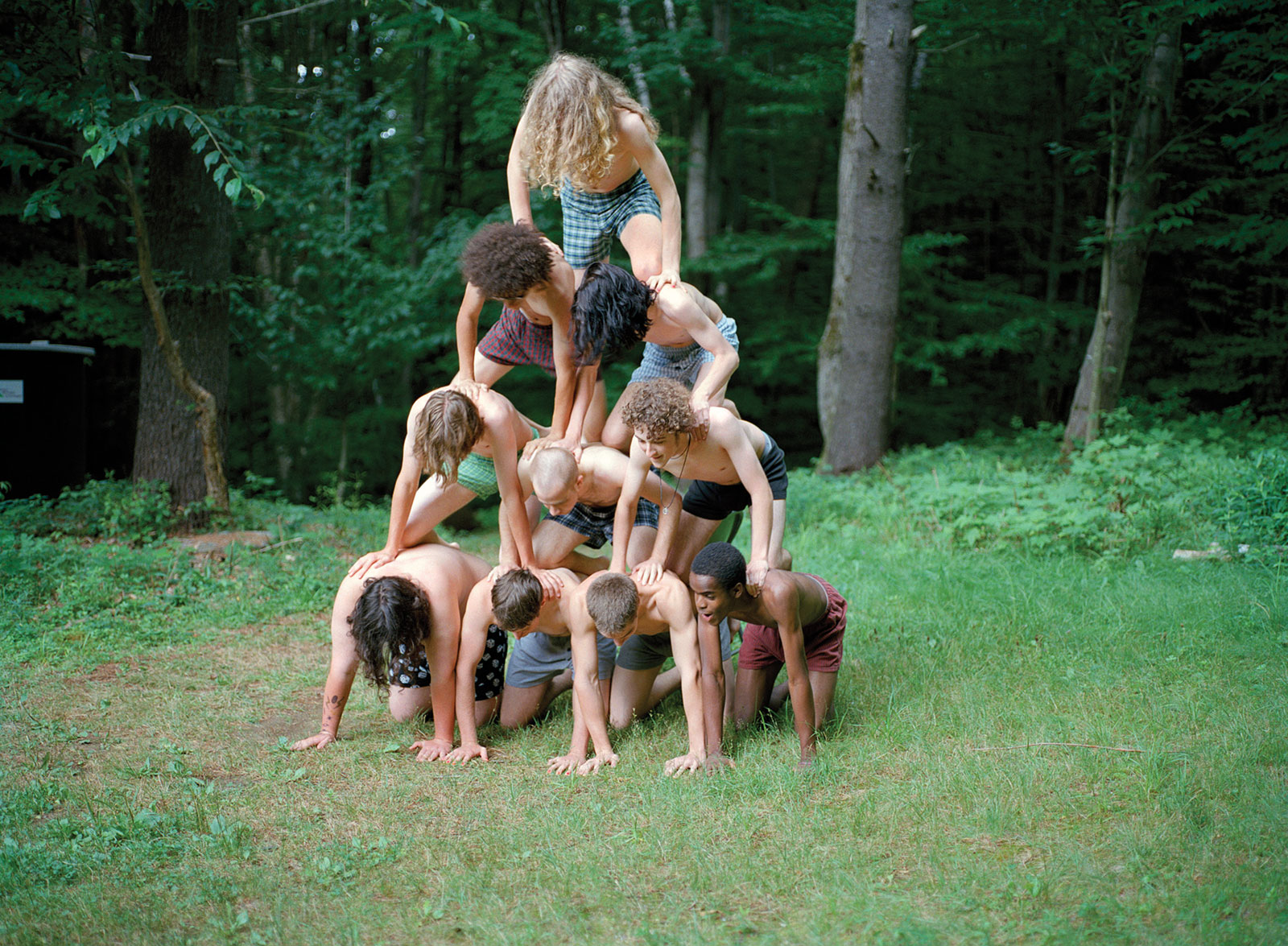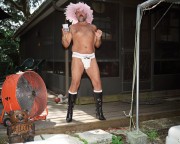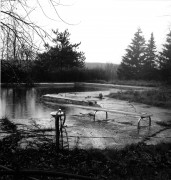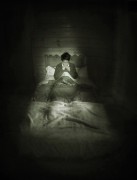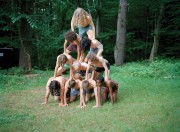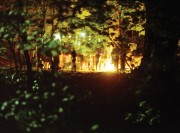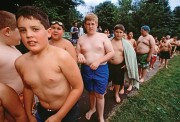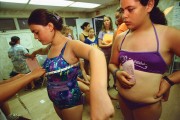Jonathan Blaustein interviews Matt Slaby co-founder of LUCEO images:
JB: I’d like to have a conversation with you about LUCEO, the co-operative that you formed a few years ago. And I know, on behalf of Rob, he would like us to talk about what people consider to be the collective model, and the role that you think its going to play in the future of photojournalism, editorial photography, and commercial photography. The goal is to see if I can get some insight for the audience, and learn some things that will be helpful to them. Maybe you could start by giving us a cursory sense of what the impetus was for you guys to get together.
MS: We started –relatively informally –in December of 2007. David Banks wrote a note to several of us, suggesting an idea that was essentially a collective model in nature, and the idea was to get together to see what we could come up with as a group to move our interest in photography forward.
JB: How did you know him?
MS: Through following his work online. I guess I’ve known him since maybe 2005 or ’06, somewhere in there.
JB: So you were aware of his work, and then he got it in his head to reach out to some people, including you.
MS: Yeah. And then, for me, it was the fourth one of these that I’d been a part of, where somebody had put out an agenda of something that they wanted to do by pooling resources to accomplish a specific goal that they set forward. The first three of these all had similar problems.
JB: Had other members of LUCEO been through other startups, like you had? Were you the only one who had been through this process?
MS: I think in any kind of formal way, yes. I think that people had been involved with different kinds of groups in the past, but just in terms of trying to move stuff forward, or groups that were trying to get things organized. I’d been invited into different formations of these. And so you have problems. You have problems of power, where you have one person that ends up doing all the work, and a lot of people that are just sort of there. You have problems of finance. How do you fund this stuff? It’s a nice idea, but how do you get people to pay in when they’re not necessarily as invested as other people. Does that make sense?
JB: Of course. I’m with you so far. Obviously, power dynamics are a fascinating function of human social interaction. I think any time you create a group of people with a common goal, anticipating problems with power dynamics is something that I imagine you thought of early on. One would imagine rules and bylaws become important quickly. Is that a safe assumption?
MS: Yes. These are some of the failings of the first three groups I was a part of. So I suggested that we all fly to a central location, because the first thing you need from people is their personal investment in the project. Whatever it is. Just taking the initiative to purchase a plane ticket, to set aside the schedule, and to go somewhere, invests people in a way that is so much different than just sending an email back and forth saying “This is a great idea, I really like it.” Because we all have the power to say that. We do it all the time. But committing to something is important.
So we all flew to one central location, we locked ourselves in for a week, and we started to outline some of these problems. We started to identify components of our ideology. We wrote out a mission statement, which is more or less driven by what all of us in the room at that time could get on the same page about. Because there are certain things that we don’t agree on, but there are certain things that we do. So you focus all that energy on the places where you have common ground. In addition to the commitment that people had showed by flying somewhere and setting the time aside. It adds to how the team gets built.
JB: It was your idea to create a structure where there was almost a buy-in. Nobody was going to get a seat at the table if they weren’t willing to bring themselves to this location. So that created a test as to how serious people were about it.
MS: I wouldn’t say that it was necessarily my idea. It was my experience of problems in the past, so it was a way we, as a group, chose to address some of those problems. To all fly somewhere and lock ourselves into a place.
JB: That part is easy to understand. I’m sure one could surmise the failures from the previous incarnations you’re talking about came from power issues. Money and power. So you guys get together and focus on the things that are important to you. I would love to hear some specifics. What did you find that you agreed upon? What was important?
MS: The first thing we needed to do was outline an ideology. What do we think is important, and how are we going to go forward. On a basic, logistical level, we needed to figure out how to divide labor. If we have six people together in one place, how do we know that everyone is doing an equal amount of work? So that one person doesn’t take all of the burden, but then everyone else gets to receive all the benefit. That leads to long-term problems. So dividing labor was an important thing.
Figuring out a system of accountability was important. One of the problems in any informal, particularly collective structure, is it’s so loose in nature that nobody is necessarily accountable to anybody else. So we had to figure out a system of accountability. We had to figure out a system of goals. The way we look at goals is both short and long-term goals. What can we accomplish right now, and then six months from now, a year from now, and then ten years from now. We look at those as being important things to keep in mind.
And the last thing we do is figure out how we evaluate that progress. When you’re working on a task, and you’re slogging through it very slowly, it’s very difficult to measure those inches that you’ve gone. Because you’re always right in the middle of it. So every six months, we take a moment at the beginning of our business meetings to look back at the last six months and say, “What did we set out as our goals? How many of those did we accomplish? What were the successes as we were working towards those goals, and what were the failures? Because the successes we can take notes on as something we want to continue in the future. But the most important part of that system is the failures, right? Being able to correct errors as you go along…to me, that’s the most critical thing. To have enough intellectual honesty and mobility to be self-critical. To look at those errors and then correct for them or build to go forward.
JB: I couldn’t agree more. I find myself saying that often. It makes sense. One can sort of piece together the fact that a group of like-minded individuals came together, both for a sense of community, and to share the costs and burdens of doing business. A lot of people would say, “OK. I get it. I can do that.” Clearly, there are many, many, many photographers out there who are contemplating trying to do what you guys have done. I think that’s a given. So we could sit here and talk about what the by-laws were, and what the structure is, and some of that is going to be proprietary information and some of it isn’t. But I think what’s more interesting, for me, is trying to get a sense of what those goals and ideologies are.
You guys click the shutter. I click the shutter. Everybody clicks the shutter. Especially now. Everybody, everybody. So if we’re back in that house in Atlanta, with pizza boxes everywhere, and testosterone, and maybe some naivete, what were you talking about? How did you want to move forward with your vision.
MS: I don’t know about the testosterone part.
JB: (laughing) Fine. No testosterone.
MS: At a basic level, one of the things that came out early on was that this is a craft that we all love to do. In talking to you, my primary vocation is as a photographer, not as a businessman just dealing in this abstract idea. I’m not selling widgets. I’m really interested in selling something that I love, and that I love to do. That was the thing that I felt most drawn to in the other people in the room at the time, and as we’ve expanded and changed as an organization, the common thread is that it’s a feeling that everyone shares. Being a photographer is not a choice. It’s not like choosing to be a CPA. It’s not like it offers some financial freedom, and so you go off and make the professional choice to be a CPA.
Photography is an imperative. So for us, what we were looking at at the time was we were looking at a market that didn’t look promising to support our relatively young careers. I think, rewinding in my head a bit, just going through a lot of the banter on all of the different channels out there, this is right at the time when a lot of newspapers were folding. And if they’re not folding, they’re folding up their photo staff. So one of the traditional entry level avenues for photographers was not looking like a viable option (if you really want to do what you love). You remember that? Maybe you don’t because you weren’t doing editorial photography at the time, right?
JB: Remember what? That everyone was pulling their hair out and going out of business? Sure. It think everyone knows that. The digital revolution has impacted creative industries across the board. Maybe we’ll touch on it right now. Maybe now’s the time to talk about it. The first couple of interviews that I did focused on the theme of fearlessness, and being willing to take risks in a time of great change and uncertainty. I know I did. I wasn’t visualizing this interview as an extension of that series, but maybe it really is. If you were to speak for your colleagues, you guys, and I know Kendrick is a woman, so forgive me if I just say guys, but the LUCEO members looked at a situation of uncertainty, and fear, and careers evaporating, and you guys decided to look for elements of opportunity. I would imagine your founding was intrinsically linked to the economic collapse, and the collapse of the industry, no?
MS: Right. I say this a lot. I worked for a guy, years ago, and I thought he was just a redneck. Horrible, horrible piece of shit of a dude. But he said something all the time that I still think is relevant. So he would say it to us in the context of someone wanting to do something that wasn’t possible at the time. For example. “I want to have lunch.” And he would say to us, (deep voice) “You know what, Slaby. You want to have lunch? Well, you can shit into one hand and wish for lunch in the other and see which fills up quickest. You know?” (laughing)
JB: (laughing) That is so good.
MS: He was such a terrible human being on so many levels. But the thing about it was, he approached things on a hyper-realisitic level. So the little gem was the one thing that I can take away from working for that guy that is applicable, sometimes, in life. And a lot of times it is applicable when things are changing in a direction that you don’t necessarily want them to. At that point, you kind of have a couple of choices. You can sit, and shit in your hand, as he said, which doesn’t do anything, or you can figure out a way to really go after the problem. In which case, you still aren’t going to have lunch, but you can figure out what your options are. Which is to work until you get lunch.
In the case of the industry, what I felt, and what other folks felt at the time, was that the industry could sit and talk about all of these things that they wanted to have happen, that they wanted to see certain things come back, and certain ways of business come back, even certain formats, right? Film. We want to see film come back 100%. But it wasn’t the reality on the ground level. So you’re left with a certain set of tools, and that’s what’s right in front of you at the time. And how you choose to approach that –that’s a business question.
This is what I meant by error correction earlier on. When we look at what our goals were, when we evaluate them, when we look at what we made mistakes on, and what we did successfully. The error correction is the important part. Because it’s how you look at those tools that are right in front of you, and correct the errors that were being made before to make something go forward. To paint a picture, that’s the reality that we had in front of us at the time.
We only had a limited amount of tools. We had a limited budget, limited access to clients and to people, we had a changing market, a changing group of clients, a changing wave of information. A lot of factors in the agency world hadn’t changed in 30 or 40 years. Technology has totally outstripped how that model worked. The example that I give all the time is that, if you’re working for an agency –and I mean a very traditional agent –somebody who has a lot of photographers underneath them, and presents them to clients.
You go back to 1970, and you’re photographing in a foreign, developing world, and you’re photographing on analog film. There’s a certain set of ground level factors that drive how that market works. It’s analog film. You can’t digitally transmit anything to anybody at that time. You take the film out of the camera, you label it, you give it to a courier, the courier goes to an airport, gets on a plane, hands it off to another courier, that courier gets on another plane and flies it over to New York, and it just keeps going, the system does, until it gets back to the agent, who prints out proofs, prints out cards, stamps his name on the back of it, it has his telephone number on it, he has to be at the desk, at the phone right there, because that’s where all of the business comes in. There’s no such thing as cell phones or Internet, and mail moves too slow. He’s supporting this gigantic overhead of all these analog pieces, in order just to get a picture from a photographer straight to the client. And so this agent has figured out this very costly system to solve that problem. The client finally calls the phone number on the back of the card that was distributed, or the agent gets on the phone and actually starts actively selling people that he knows. That’s how business is done.
JB: Right. But that business is also information dissemination. You just described what sounds like the Silk Road compared to 2011, for information dissemination. What you’re saying, is in your experience creating your co-operative, you were looking very clearly at the fact that the existing agency model for an almost comically different system to disseminate information. And therefore could not possibly be as relevant today as it was 50 years ago.
MS: It could be if it made certain changes, but there are certain things that didn’t happen. The percentage cut didn’t change. That percentage cut supports an enormous overhead. And that never changed. But certain things did, to make stuff cheaper and more efficient. And that’s best exemplified by the fact that the two of us are literally talking to each other from several hundred miles away over a video chat.
JB: No doubt.
MS: And this is free. This costs us nothing other than our Internet connection. These are tools. This is not the only tool available to people who are in business…
JB: Of course. We all love to say, “I’m a photographer. I love to photograph.” You said you guys got started as a group because you all love to photograph. But there was nothing standing in your way of taking pictures. You guys wanted to get paid for your time, and to get paid for your efforts.
MS: I actually want to interrupt you on that point. I know where you’re going with it, but I just want to correct the course a little bit. There’s nothing standing in your way of taking pictures, but for the fact that photography, unlike sketching with charcoal, is an expensive, expensive thing to do. And without that money coming in…surely there will be photographers reading this in this position, and we all know photographers who are in this position, they’re taking on enormous amounts of personal debt, enormous amounts of personal risk, just to be able to continue making those pictures. And that’s nice, and it puts the photographer in sort of the starving artist/victim role, but it doesn’t really answer the fundamental question: how does a photographer make enough money to fund significant works throughout a full, 30-year career?
Significant bodies of work happen because photographers have the opportunity to produce over long periods of time. They have a career where they refine and develop their craft, where they get to look at things critically and get to hone whatever their style and message. If you look at the cost over that period of time, you have to have some sort of revenue stream coming in. It can’t just be the credit card. It can’t just be the loan, or this idea that somewhere down the road, you’re going to be discovered and it’s going to make everything OK.
This is where several important things come together. The idea that photography is important, that we love to produce photographs, and that we want to continue working as photographers. Those are the goals. So how do you take good business practices to support that? And that’s where we take off from.
JB: OK. There are so many ways to talk about photography. I think visual communication is obviously the key element. But a lot of people love to focus on the story, and storytelling. So you’re a bunch of image maker/story tellers who want to be able to support that practice. And you decide that you want to come up with a, if not new, updated system of business practices to be able to get work and get paid for your endeavors. What were some of the decisions that you all made that are distinct from what other people are doing?
MS: One of the things that we did is we just backed off from the whole question, we just said, outside how this has been done in the past, let’s just look at business across the board. How do other people in business and other industries answer these questions. One of the things that I think was immediately apparent, and our primary focus is really marketing each others work…
JB: Through the Web. Through the Internet.
MS: Not just the Web. The Internet is just one means that we use. We have several mailers that go out each year. We have an email system of marketing that we maintain. We have our social media. Which is huge. Hugely important. Through Facebook and Twitter that reaches a particular audience. We look at our audience as broadly. For example: Who’s buying the product? Who’s a student that may move into the position where either they’re a photographer that we’re interested in, or end up in a position to hire us? Who falls into the fan category? You don’t have to just reach the person who’s purchasing from you to make an impression. So we have those avenues, which are traditional.
But then, for the last couple of years, we’ve done a gallery show, a group exhibition that’s been hugely successful. Both years, standing room only. The first year we did it with MJR collective, where we put together our photographers and their photographers in a space, and brought in different buyers and different photographers for the evening. Then we did it again this year, and we had a panel discussion ahead of time. On the panel we had Bess Greenberg, the gallerist from 25 CPW who hosted the event. We had Brian Clamp, of ClampArt, the curator for the show. James Estrin from the New York Times Lens Blog sat on the panel, and Paul Moakely of TIME Magazine sat on the panel.
In addition to getting to showcase our work, we also had this component where it was important for people who are into photography and interested in seeing where it’s headed be able to come into listen to people who were in a position to talk about it. That was in the dead of winter in New York City, and during the panel part of it, we literally had people standing out in the cold, because there was no room to come in to listen from inside. So that’s an important piece.
JB: You guys are in a position where you have, literally, not metaphorically, been anointed the future of photojournalism by, as you said, James Estrin from the New York Times. Your opinions are solicited everywhere. It seems to me that the primary reason for that is that the model that you guys are using has enabled you to work a lot. I know that most, if not all of you, are working consistently for major publications. So all of a sudden, everyone, including myself, wants to talk to you as if you have all the answers. So the idea that people would be literally pushing each other out of the way in their big, heavy coats, to me it connects right back to why we’re having this conversation. Which is: people want to figure out how to pay the bills and they think that you have the answers. I would imagine it’s a difficult position to be in…
MS: It’s not an answer though. We talk about it in our group a lot. A lot of times we run up against a problem where we want a quick solution. Where we want something to happen tomorrow. But the truth of the matter is that anything that’s important in life, whether it’s business or personal, there’s no such thing as a magic bullet that solves all of your problems. It takes work and it takes making mistakes. Again. The best answer that we have now is that we’re open to making those mistakes, and when we make them, we really work to correct them or to improve upon them. Error correction more so than a course of action.
JB: Do you think that that is common knowledge? I talked about self-awareness and self-criticality in each of the interviews that I’ve done. Yet I wonder whether other people place the same value you do on the opportunity of failure. What do you think about that?
MS: Again, I’m going to talk in big, general terms about where I think photographers have been. I think there’s been a cultural emphasis on the photographer as a lone wolf. That’s a real draw. That’s why people get into this profession is because there is this…
JB: Competitive people as well.
MS: Sure. But the photographer operates independent of everything else. They’re out there on the fringes, on the edge of whatever it is. We just deal with photography as a sub-culture, we value that.
JB: The distanced observer.
MS: Exactly. We value that. Part of the problem is that as we tip into 2012, which the UN is calling the year of the co-operative, as we tip into these more collaborative times, when we have all these tools to collaborate, it’s becoming more and more of a challenge to be that person, to really be that lone wolf, an isolated person, and still make forward steps. Because one of the things we’ve found is that by working together, by funding ourselves together, and by dividing up our tasks so that we can minimize labor, we can maximize specialization in terms of what we do. We can make bigger steps than if we’re just one person working. That doesn’t mean that you can’t go and shoot your pictures as an isolated person. It just means, in my opinion, that you have to draw the line between how you’re shooting and how you’re running your business. Keep those two things very separate. One supports the other.
JB: Historically, artists and/or creative types have a reputation for left brain thinking, and maybe not being quite as skilled or astute in business practices. It seems like, certainly in today’s market, one needs to be equally adept at both. I’m looking at you, and you’re not rolling your eyes or anything, but…
MS: I’m thinking.
JB: So where do you see people going wrong. What would you say are some of the most common misconceptions about how to handle the business aspects of having a successful photographic career?
MS: This is where it gets too judgmental, right? I don’t want to judge someone who’s been doing this for 20 or 30 years and doing it successfully, because obviously they’ve figured out something that works for them. It’s the same thing, but the place where it seems the most problematic is where the error correction stops. The assumption that doing the same thing will give you the same results in spite of the fact that the situation on the ground changed. The digital age is here. I don’t just mean digital photography. The tools that we have to reach clients and communicate with each other, how we find and close sales, it’s all here. The idea that doing the same thing we were doing in 1985 is somehow going to net the same results in 2011 is problematic. So it really is in the error correction. The ability to be self-critical.
JB: So you guys are a group of like-minded photographers, you get along, you set up a system that thusfar has been working for you. Let’s talk about everyone who is going to try to ape that model. When you and I first started talking about this interview, you were very specific about the fact that LUCEO was a co-operative and not a collective. I’m curious to see how you view the distinction, and then I’m curious to see what you think others can do to succeed without impinging upon your successful practice.
MS: This is our opinion. The idea of a collective is a loose-knit group of people that put their work in the same place. The clear objectives aren’t necessarily there. It’s a collection of material. Outside of photography, the idea of a collective seems to be hamstrung by certain things, like the idea that all voting has to be by consensus. There is no formal voting procedure.
A collective is inherently informal, and I’m sure that’s going to piss off somebody who’s reading this. Somebody else will say that they have a collective model and that what I’m saying is not the case. I’m sure that that exists. But, for us, not only do we want to put our material in the same place, but we have a central mission and a central purpose for doing that. We have a real clear procedure for how we vote and how we move forward. We have a real clear procedure for accountability. We have those internal workings that actually make us do the root of that word: co-operate. To work together to accomplish a common set of goals. That’s what a co-operative is about.
JB: And the long term goal for you guys is then clear. Each of you wants to be able to have a photographic career of multiple decades where you can learn and grow, and your vision can evolve over time. And you can be compensated as such.
MS: Specifically to support significant work of our members and significant photographic work outside of the organization. Part of what we’ve developed over the last year is a whole separate fund which addresses just that question. In addition to how we raise money for our regular budget, we also take a percentage from the commissions of all of our members, each month, and put it into a separate project fund that supports our photographers inside of the group, and also supports photographers outside of the group. Coming up, we’re going to do our second Student Project Award that will be announced at LOOK3 this year. We’ve also been dabbling in some of these crowdfunding ideas. We’re taking money out to offer a little each month, saying, “Hey, we like what you’re doing, here’s some support.”
JB: (Deep voice) Here you go, kid. Here’s $20. Don’t spend it all in one place.
MS: But there’s truth to that. You’ve got to support as you can. So we’ve figured out how to do that. We’ve got a budget for outside of the group, as well as inside. The fund is built, and then our members can apply for very specific purposes.
JB: Just to ask clearly, and maybe you were about to say this, but if we’re talking about this and you’re saying that you guys are open to funding outside projects, then you can bet that as a result of this conversation, you’re going to get emails.
MS: Go to the About tab on our website, and that’s the easiest way to find out about this program. The Student Project Award is prominently featured, but we also do a chunk of funding on a monthly basis through Flattr, and we’re discussing stepping into a third realm as well for project-based ideas. The easiest way for someone to receive direct funding for us would be to sign up for Flattr. Then send us your project through Facebook, or send us a tweet, and we can take a look at it. If it’s what we want to Flattr for that month, then we will.
JB: You’re putting your money where your mouth is.
MS: You have to. Because it truly is important to us.
JB: I’m not sure if people are aware, but you’re a lawyer. So LUCEO, as an organization, has an in-house lawyer. And I have to ask, given how expensive legal fees can be, so obviously that’s an inherent advantage for you. But if we’re talking about the people who are going to try to create similar organizations, do you think that it becomes prohibitively expensive for a group of photographers to be able to hire a lawyer on a regular basis.
MS: That’s obviously one way that we save money, but just because I’m a lawyer doesn’t mean that that’s where all the savings are taking place. They take place across all of the different tasks that we have. Social media, marketing, human resources, web development, these things are all costly, and they’re things that we’ve been able to divide up and keep largely in-house. We contract out for very specific things, but the project management tends to stay in house.
When it comes to what does a lawyer does, my role in the group is largely administrative –it’s the skills that I’ve picked up from law school –and the basic business sense that you get from being in law school. Doing the finances, working out how budgeting works, and administrative stuff regarding how our business gets set up. The nice thing about being in the United States right now is that we’re a society that values business and we tend to believe that business is something that shouldn’t be prohibitively costly to set up. And, generally speaking, it’s not. So it’s something that people have done for a lot longer than we’ve been alive
JB: So you’re division of labor is such, within the co-operative, that people are using their existing skill-sets and areas of expertise. Therefore, to those people who are considering trying to build something along those lines, that would be something that is important to pay attention to. Which is, how can I collect a group of people who have specific skill-sets on top of being talented photographers.
MS: Specific skill-sets are important. Also the openness and the ability to learn. One of the things that we do, if we don’t know how to do something, we’re really good at taking measures to learn how to do it ourselves. Or to learn what we need to do to minimize its cost. It lets us specialize. My workflow isn’t spread across 100 tasks a day –which, if you’re running your own solo business, that’s what it is. My tasks are really focused on a narrow set of things. The same way that Kendrick and David and Matt and Daryl and Kevin’s tasks are focused. Does that make sense?
JB: Of course. We’re talking about capitalism and business as much as we’re talking about photography, which I think is important. Specialization of skills, breaking tasks down, that’s straight out of Henry Ford. That built America. And what you guys are talking about is just that. We are a business, we are an organization, we are a corporation, essentially, of photographers that support our own work. There are costs associated with having every aspect of a business practice, and you guys splitting up the costs, splitting up the work, and creating a very strict set of rules that guide the organization.
So I appreciate that you’ve been generous with your time, and we’ve certainly covered a lot of ground in this interview. But is there something that you’d like to talk about, something that’s interesting to you, that we haven’t had the opportunity to discuss?
MS: You know, starting out with how we founded LUCEO, how we came about, is not that germane to where we are right now. Because there’s a point where we went from being an idea to something that was very real. And that happens not in December of 2007, but over the course of time.
JB: Well, I asked you a question at the start, and I’m willing to admit it was an obvious question. In a linear narrative, you start at the beginning. So let’s talk about what you want to talk about. If it’s not that interesting how you started, what’s more interesting?
MS: I think the most engaging things about what we do happen when we refine our strategy. When we understand ourselves as photographers, as people, but also as component pieces of a team. Once that’s up and running, that’s the most relevant thing we have.
JB: How you grow?
MS: Yeah.
JB: So give me an example.
MS: An example of?
JB: Of how you guys have grown and improved in the last year, or in the last six months. What do you know now that you didn’t know when you started?
MS: See, now I got myself in a hole, right? Because now I’ve got big, broad questions…
JB: You did it. (laughing.) I’m good, bro. You opened yourself right up. Come on, give me the goods.
MS: (laughing.) This gets back to the idea of the magic bullet that we were talking about earlier, that the biggest misconception starting out is that everything is going to be solved in short order. The thing that was important to us is that we took our growth in tiny steps towards progress that ultimately landed us a bigger goal.
For example, take our recent gallery show. A lot of money and a lot of different components went into that show. We need the space, we need the marketing to get to the people, we need a press campaign, we need a social media campaign. On top of all this, we have a budget that we have to stick to, because we don’t have flexible capital that goes forever. We have basic stuff like printing, hanging, curation. We have another component of an exhibition catalogue. And on the night of the show, everything has to get on the wall. We need to get the curator to help design the show while we’re hanging, we need to get someone to watch the space. We need to have alcohol for the people who are there. All of these little components are important things. When I think about people trying to start an organization like this, these organizational components are the absolute most critical things out of anything that we do.
And over the years, how we’ve refined what we do and how we work together to accomplish all of that stuff. Dividing up tasks between people, giving them responsibility for different components. Each one of these people is accountable. I think that’s the most important lesson outside of just correcting our errors, has been to figure out how to get people, as heads of all these different components, accountable to the entire group to get this thing done.
JB: It makes a lot of sense. I’m going to ask you a question, and maybe we’ll call it our last question. I admit that it’s somewhat difficult, but I think that the answer, if it’s what I think it’s going to be, is important. And that is, maybe you can’t speak for everybody in LUCEO, but you personally are working for the biggest publications in the United States, at present. Time, The Wall Street Journal, Newsweek. Were you working for any of those folks before you formed LUCEO?
MS: Sure.
JB: You were?
MS: I interned at US News & World Report, which my intro into the magazine world.
JB: I thought you were going to say no. I was going to tie a bow on it right there for you.
MS: That’s OK, because there’s qualifications that go with this.
JB: Of course there are qualifications. I’m talking to a lawyer. I’m parsing my words carefully.
MS: So that’s my introduction the magazine world, but the problem was not finding all these contacts and figuring out how to get jobs from them. I think that’s something that Rob said on the blog a long time ago, was that if you have a solid core of editorial clients, you can make it. So the problem was not a matter of finding a client or two where I’d work for maybe a few months. But finding four loyal clients that would keep coming back that I could keep producing for in the future. Which is more than just making a phone call. It’s more than just knowing a person from a cocktail party and then they throw you a bone every now and again. You’re now dealing with this question of business, which is how you market to those people, how you make sales to those people, and most important, how do you retain them as a client.
JB: So, my leading question aside, we can say that where you’re at right now is a direct function of the fact that you and your colleagues formed this organization, and have had the ability to tweak the process as it’s evolved. You guys are working now more than before you formed LUCEO.
MS: Positively. So what LUCEO has done for me, in terms of just numbers…my first year in business was largely funded by me. On my own, I was doing a lot of the components that LUCEO now does as a group. So I have a control year to compare stuff to. Now, I spend roughly half of what I spent on marketing in that first year. So it’s cheaper for me to market with LUCEO. I reach 10 times as many potential clients –and that’s an honest number –through LUCEO than I did on my own. And my business has grown, at minimum, 30% each year since the formation of LUCEO.
JB: Which correlates directly to the Great Recession.
MS: Right.
JB: 30% growth while everyone else was tanking. Hopefully that won’t come off in an obnoxious way, but if we’re coming to the close of our conversation, collectives, collaboratives, business practices, these are dry terms. And I feel like maybe we’ve just gotten to the root of what’s going on here. It is something that you spoke about directly. It’s about people working together, with common goals, towards a common cause. You guys like each other, you understand each other, you work well together, and you’ve built a team concept in place of the lone wolf model you discussed earlier. As such, LUCEO is enjoying success. It’s not an accident.
MS: Right. So on top of the figures and the numbers, something else nice about this group is there’s a certain moral support and ability to talk through problems that you don’t have when you’re operating on your own. Nobody in LUCEO is on a little life raft out in the middle of the ocean.
JB: It’s built-in community.
MS: Right. If I have a bid that I’m having trouble working through, then I can call on Kendrick, and she may have done the bid before, and she can talk me through how that works. And from the perspective of a photographer, having community, and feedback, and encouragement and criticism is critical. That’s something that we participate in on a regular basis. Sharing and showing work.
JB: You know, Matt, we’ve talked about a lot of things, and in a somewhat natural way, we’ve managed to get at the heart of what I was hoping for. I feel like you’ve been generous in sharing some of your insights about not only how you started, but where you are and what you’ve learned. It’s not your place to go out and say, “Hey, photographers, you all should get together and do what we did.” Nor would that maybe be in your best interest. At the same time, the core idea is that this type of collaboration and community, when built upon fundamental business practices, might well lead other photographers to be able to rebuild their income or rebuild their practice, or adapt to the current climate. I think that’s very generous of you.
MS: But it’s about outlook, too. When you’re saying it might not be wise to make those suggestions, that people form collectives or co-operatives, I don’t actually have that feeling. If I look at my own regional market, Denver, and I look at who I’m in competition with and who I’m not in competition with, I know a few things about this market. One, there’s enough work coming into Denver every day to support everybody in this city who loves photography. Two, there’s a subset of photographers that don’t love photography, that don’t love what they’re doing, and are just kind of going through the motions. So when I look at who my real competition is, it’s not the people who love what they’re doing. There’s enough work here for more than just me.
JB: I was trying to be realistic about the competitive nature of this profession. At the same time, personally, I have reached a place now where I’ve decided not to be concerned with what other people are doing. And to do my own thing, and to believe that it’s going to work out the way it has been. Maybe the big idea here, maybe the really big idea is with the fundamental shift in communication technology, which is beyond core to the way humans function, right now, that maybe we don’t need to fall back on that inherent assumption that competition is in our blood. Are are we really talking about the fact that collaboration, working together in intelligent ways, makes more sense than viewing other people as your competition?
MS: Yes. There’s an internal contradiction that can happen, and I think it’s important to navigate around it. If I say that photography is important to me, and that I love photography, that doesn’t mean that I love my own photography and nothing else. I want people who love what they do to be successful. And I want people who are producing significant pieces of work to be successful. I don’t want them to go away. This isn’t Highlander, you know? It’s not that there can be only one.



